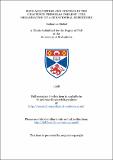Files in this item
Song acquisition and control in the chaffinch 'Fringilla coelebs' : the organisation of a behavioural repertoire
Item metadata
| dc.contributor.advisor | Slater, Peter | |
| dc.contributor.author | Riebel, Katharina | |
| dc.coverage.spatial | 148 p. | en_US |
| dc.date.accessioned | 2018-07-06T15:11:25Z | |
| dc.date.available | 2018-07-06T15:11:25Z | |
| dc.date.issued | 1998 | |
| dc.identifier.uri | https://hdl.handle.net/10023/15068 | |
| dc.description.abstract | Bird song provides us with one of the best models with which to investigate learning, communication and the organisation of behavioural repertoires. This study describes temporal organisation and song pattern choice in the chaffinch in order to develop hypotheses for possible song control mechanisms. Influences of the song learning process and motivation on performance are tested in experiments. The role of nature and nurture in shaping females' song preferences is investigated by using operant tasks. A first quantitative assessment of temporal organisation within songs is provided in Chapter 2. Chaffinches sing with eventual variety, each song type in a male's repertoire is repeated a few times before a switch to the next type occurs. Chapter 3 tests two hypotheses for mechanisms controlling song type switching: that a maximum number of repetitions or that a maximum duration (time window) sets the upper limit. Clear evidence for a time window as an upper constraint was found in wild birds as song type bouts with many repetitions were sung at fast rates only, whereas those with few repetitions could be sung at either fast or slow rates. However, the mean number of song type repetitions depended strongly both on the subject and the song type. No evidence could be found that number of repetitions per song type were influenced by the tutor's singing style in hand-reared chaffinches (Chapter 4). Playbacks of single songs to wild males revealed the motivation dependent flexibility of the system as the birds reacted with distinct increases in bout duration (Chapter 5) but showed a different response to playbacks of songs that were the same or different from that being performed by the subject. Song was used as a positive reinforcer in an operant conditioning task with female chaffinches (Chapter 6). The influence of early exposure to song on later preferences and the relative importance of the trill and flourish sections of the song were tested this way. Females showed no preference for familiar over unfamiliar songs, but preferred songs with flourishes over those without. | en_US |
| dc.language.iso | en | en_US |
| dc.publisher | University of St Andrews | |
| dc.subject.lcc | QL696.P246R5 | en |
| dc.subject.lcsh | Finches | en |
| dc.title | Song acquisition and control in the chaffinch 'Fringilla coelebs' : the organisation of a behavioural repertoire | en_US |
| dc.type | Thesis | en_US |
| dc.contributor.sponsor | Doktoranden Stipendium-aus Mitteln des zweiten deutschen Hochschulsonderprogramms (HSPII/AUFE) | en_US |
| dc.contributor.sponsor | University of St Andrews. St Leonard's College Scholarship | en_US |
| dc.contributor.sponsor | Marie Curie Fellowship Association | en_US |
| dc.type.qualificationlevel | Doctoral | en_US |
| dc.type.qualificationname | PhD Doctor of Philosophy | en_US |
| dc.publisher.institution | The University of St Andrews | en_US |
This item appears in the following Collection(s)
Items in the St Andrews Research Repository are protected by copyright, with all rights reserved, unless otherwise indicated.

